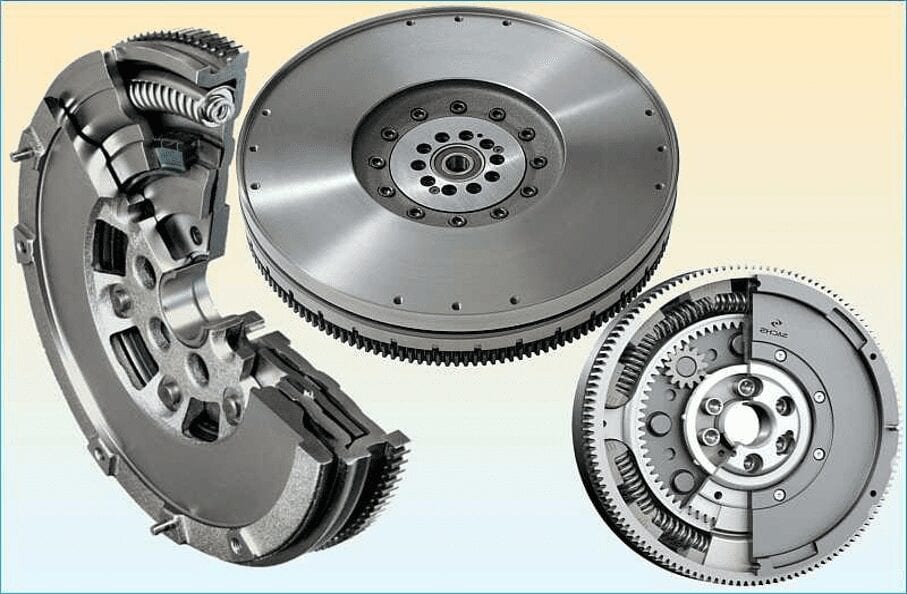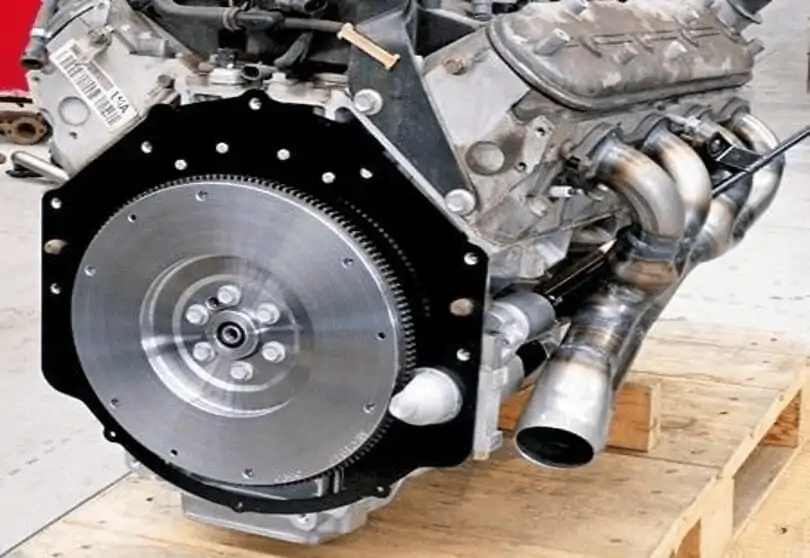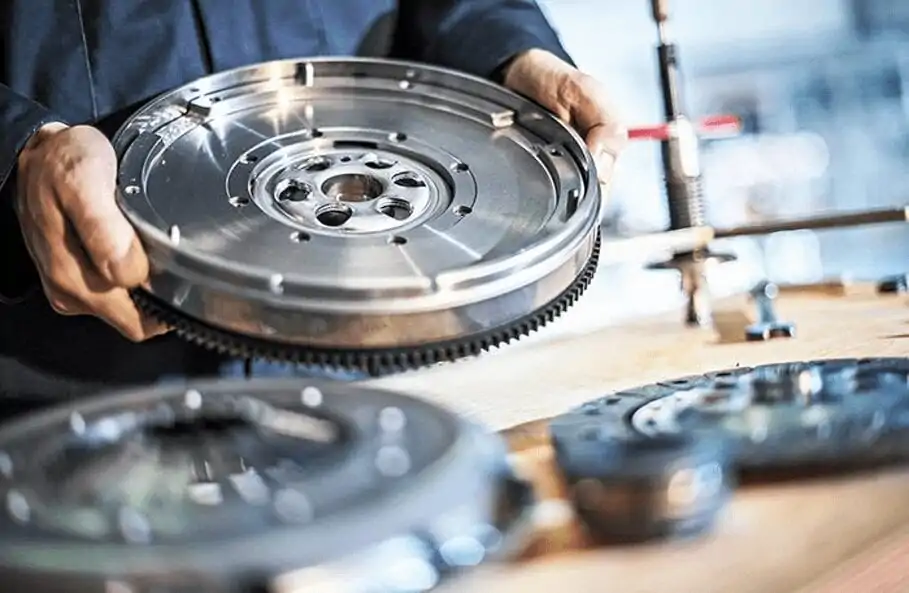
How does a flywheel work?
Content
Modern cars consist of many parts and components, each of which plays an important role.
What is a flywheel and what is its role?

The flywheel, as a rule, is a disk of heavy metal with a diameter of 12 to 15 inches, outside of which is a metal gear crown. It is mounted on the crankshaft of the engine and is located inside. Thus, the flywheel is structurally connected directly to the engine, clutch and gearbox.
The functions performed by the flywheel are several:
Helps to start the engine
When you get in the car and turn the ignition key, a small gear called the “Bendix” is turned on with the flywheel and turns it. He, in turn, rotates the crankshaft, which begins the compression cycle necessary to start the engine. As soon as the internal combustion engine starts, the Bendix is “removed” and allows the flywheel to rotate smoothly.
Normalizes engine speed
After starting the engine, the crankshaft converts the movement of the pistons up and down into rotational motion. However, this movement is oscillatory, since power is generated only 2 or 4 times (depending on whether the cylinders are four or eight) per engine revolution. To maintain a constant speed of rotation of the crankshaft with each movement of the pistons, the mass of the flywheel is used by inertia.
Reduces engine vibration
Since the pistons are offset from the center of the crankshaft, the engine vibrates violently because each piston moves at a different angle. The large mass of the flywheel inhibits this movement and helps both stabilize and balance the engine and reduce vibration throughout the car.
Reduces component wear
By stabilizing vibrations and smoothing the engine speed, the flywheel limits wear on other important drive components.
Types of flywheels and their features

Modern cars use mainly one-piece (single-mass) and two-mass (DMF) flywheels. Each of the types has its own characteristics, advantages and disadvantages.
Single mass flywheel
This type of flywheel is widespread among older car models. In fact, these are massive cast iron discs with a continuous structure with a diameter of 300 to 400 mm. Outside the single-mass flywheels, a steel ring is installed.
The main advantages of this type of flywheels are their simple design and low cost.
However, single-mass flywheels have one serious drawback: they cannot absorb torsional vibrations well enough.
Two-mass flywheel
Two-mass flywheels, also called shock absorbers or two-mass flywheels, are a relatively modern development, first used in automobiles in 1985.
What does this mean?
Structurally, this type of flywheel consists of two separate discs, which are interconnected by radial and thrust bearings. One disc is part of the crankshaft and the other is part of the clutch. Between the discs is a spring-loaded damping mechanism that dampens vibrations and protects the gearbox from vibration loads.
Among the advantages of dual-mass flywheels it can be noted that they significantly reduce the vibrations transmitted by the engine to the transmission, protect gears from overload and reduce fuel consumption.
However, we must admit that this type of flywheel has several drawbacks, the main one being that they are not as reliable as single.
It is indisputable that the springs to which the damping disks are connected experience significant loads, which leads to their rapid wear. Another disadvantage is that they are still significantly more expensive than single ones.
Each flywheel, single or dual-mass, when used correctly, is sufficiently resistant to load. If we are a little more specific, we will say that with proper use the flywheels can withstand mileage of more than 350 thousand kilometers. Of course, the flywheel is subjected to heavy loads and can wear out much earlier than the manufacturers expected.
Major problems requiring flywheel replacement
Problems with the flywheel are mainly related to improper operation of the car. In particular, what can make you change the flywheel:
Critical overheating
the appearance of cracks and wear on the friction surface
overheating or oil leak inside the dual-mass flywheel
destruction of its arc springs, etc.
Symptoms warning of a flywheel problem
Switching problem
When you try to shift gears, but instead of the clutch reacting adequately, the next gear cannot go or go, but immediately returns to the previous one, this is most likely due to a worn flywheel. In this case, you will hear a loud noise, such as grinding and friction.
The smell of burning
One of the main symptoms of a worn flywheel is the smell of burning, which can be felt even inside the car. This smell occurs when the clutch malfunctions, which produces a lot of heat.
Vibration when you press the clutch pedal
If you begin to feel vibrations when you depress the clutch pedal, this is usually a sign of wear on the flywheel spring bearings.
Strong crash when starting a cold engine
We clarify that this symptom is characteristic of two-mass flywheels. When the shock absorbing springs are worn out and you start with a cold engine, you will hear a loud rumbling sound.
This rattling usually lasts a few minutes after starting the car, after which it disappears. If you start to hear it more and more often in the morning when you start the car, this is a clear signal that you need to pay attention to the flywheel.
Is flywheel maintenance possible?
Flywheel service is almost impossible to perform. It is usually checked when replacing the clutch disc for tooth wear or other problems. If they are, the flywheel is replaced, and if there are no problems, you can continue to use it.
Can the flywheel be repaired?
A single-mass flywheel is difficult to repair, so when it wears out, it must be replaced with a new one. (The only thing that can be replaced with it is a dental crown, if one of the teeth is worn or broken).
Two-mass flywheels began to be recycled in recent years.
What does flywheel repair mean?
Generally speaking, recycling separates the two flywheel disks and cleans them well. Then the bearings, springs and all other elements are replaced with new ones, and both discs are riveted again. Finally, the adjustment is made, and if everything is in order, the flywheel is installed in place in the car.
This method of restoration of two-mass flywheels, as already mentioned, is quite popular, but does not always give good results. Sometimes, when discs are opened for reuse, this is not possible.
In addition, although almost all repair shops provide a guarantee after disposal, no one can guarantee that all items have indeed been replaced with new ones.

How to change a flywheel?
Replacing this component is quite a difficult task, and if you do not have good technical knowledge and specialized tools, it will be difficult for you to do it yourself. Why?
To replace the flywheel, you must first remove the gearbox and clutch. This not only takes a lot of time, but also requires specialized tools to be executed correctly.
If you still decide to do it yourself, we advise you to purchase a clutch kit with a flywheel in the kit. Thus, you will be sure that you have taken care not only of the flywheel, but also of all the clutch, and those that are so important for the efficient operation of the car will last you a long time.
Questions and answers:
What are the main functions of the flywheel? The key task of a flywheel is to transmit torque to the clutch basket. The engine is also started through the flywheel, this part provides inertial forces that facilitate the operation of the crankshaft.
What is a flywheel and what is it for? It is a disc-shaped piece attached to the engine crankshaft. The flywheel ensures the uniformity of the angular velocities of the crankshaft, the transmission of torque to the transmission, and the damping of torsional vibrations of the engine.
Where is the flywheel in the car? It is a large disk with a toothed rim at the end. The flywheel is located at the rear of the engine (at the junction of the internal combustion engine and the box) on the opposite side of the timing belt.
How does the clutch flywheel work? The single-mass flywheel rotates with the crankshaft. The dual-mass flywheel additionally dampens torsional vibrations (in standard flywheels, this function is performed by the clutch disc springs).

One comment
anonym
The literally translated article is hard to read